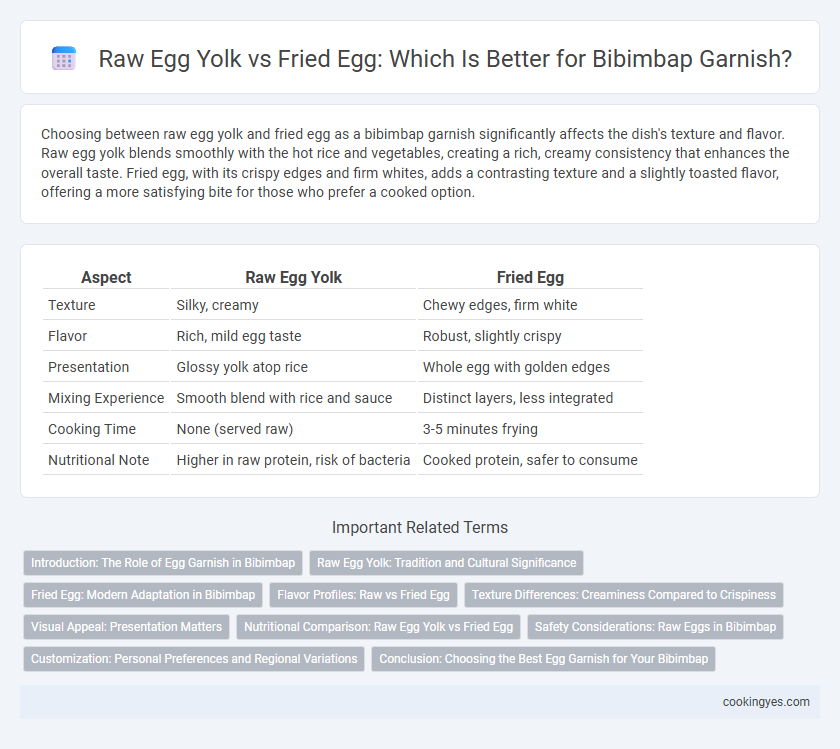Choosing between raw egg yolk and fried egg as a bibimbap garnish significantly affects the dish's texture and flavor. Raw egg yolk blends smoothly with the hot rice and vegetables, creating a rich, creamy consistency that enhances the overall taste. Fried egg, with its crispy edges and firm whites, adds a contrasting texture and a slightly toasted flavor, offering a more satisfying bite for those who prefer a cooked option.
Table of Comparison
| Aspect | Raw Egg Yolk | Fried Egg |
|---|---|---|
| Texture | Silky, creamy | Chewy edges, firm white |
| Flavor | Rich, mild egg taste | Robust, slightly crispy |
| Presentation | Glossy yolk atop rice | Whole egg with golden edges |
| Mixing Experience | Smooth blend with rice and sauce | Distinct layers, less integrated |
| Cooking Time | None (served raw) | 3-5 minutes frying |
| Nutritional Note | Higher in raw protein, risk of bacteria | Cooked protein, safer to consume |
Introduction: The Role of Egg Garnish in Bibimbap
Egg garnish plays a crucial role in Bibimbap by enhancing texture and flavor complexity. Raw egg yolk creates a creamy, rich consistency that binds rice and vegetables together, while fried egg adds a crispy texture with a slightly savory note. Both variations elevate the dish's visual appeal and contribute essential protein, balancing the traditional Korean meal.
Raw Egg Yolk: Tradition and Cultural Significance
Raw egg yolk in bibimbap remains a cherished tradition, symbolizing purity and freshness that complements the dish's vibrant flavors. Its creamy texture blends seamlessly with the warm rice and assorted vegetables, enhancing the overall sensory experience. Rooted in Korean cultural heritage, the raw egg yolk garnish reflects a respect for natural ingredients and authentic culinary practices passed down through generations.
Fried Egg: Modern Adaptation in Bibimbap
A fried egg as a garnish in bibimbap introduces a modern adaptation that enhances texture and flavor by providing a crispy edge and a fully cooked yolk, contrasting with the traditional raw egg yolk's creamy richness. The fried egg's distinct golden color and slightly caramelized surface create a visually appealing finish that complements the vibrant vegetables and seasoned rice. This variation caters to health-conscious diners who prefer cooked eggs while maintaining the dish's authentic balance of savory and umami elements.
Flavor Profiles: Raw vs Fried Egg
Raw egg yolk in bibimbap offers a rich, creamy texture that blends smoothly with the spicy gochujang and warm rice, enhancing the dish's umami depth. The fried egg provides a contrasting texture with a crispy edge and firmer white, adding a savory, slightly caramelized flavor that complements the fresh vegetables and marinated meat. Choosing between raw or fried egg affects the overall mouthfeel and flavor harmony, catering to preferences for either silky richness or a more robust, textured finish.
Texture Differences: Creaminess Compared to Crispiness
Raw egg yolk enhances bibimbap with a rich creaminess that evenly coats the rice and vegetables, creating a smooth and velvety texture. Fried egg adds a contrast with its crispy edges and firm whites, contributing a satisfying crunch and more defined layers within each bite. Choosing raw yolk emphasizes a cohesive, luscious mouthfeel, while a fried egg introduces textural variety and crispness to the dish.
Visual Appeal: Presentation Matters
A raw egg yolk atop bibimbap creates a vibrant, glossy centerpiece that enhances the dish's colorful vegetables, contributing to an authentic and appetizing presentation. Fried eggs add texture with crisp edges and a golden hue, offering a rustic visual contrast against the steamed rice and seasoned ingredients. Choosing between raw and fried egg yolk impacts bibimbap's visual appeal by balancing traditional aesthetics with personal style preferences.
Nutritional Comparison: Raw Egg Yolk vs Fried Egg
Raw egg yolk in bibimbap retains more vitamins like B12 and folate, as well as essential fatty acids, due to minimal heat exposure. Fried eggs offer higher protein bioavailability and reduced risk of Salmonella but may lose some heat-sensitive nutrients through cooking. Choosing between raw egg yolk and fried egg impacts the dish's nutritional profile, balancing vitamin retention against food safety and protein digestibility.
Safety Considerations: Raw Eggs in Bibimbap
Using raw egg yolk as a garnish in bibimbap requires careful attention to food safety, as raw eggs may carry the risk of salmonella contamination. Opting for pasteurized eggs or thoroughly washing eggshells can reduce the risk of foodborne illness when using raw yolks. Fried eggs provide a safer alternative by eliminating bacteria through cooking, ensuring the bibimbap is both flavorful and safe to consume.
Customization: Personal Preferences and Regional Variations
Raw egg yolk in bibimbap offers a rich, creamy texture that blends seamlessly with the hot rice and vegetables, appealing to those who prefer a silky mouthfeel and authentic Korean tradition. Fried egg garnishes provide a crispy edge and more pronounced flavor, favored in regions or households that enjoy contrasting textures and a heartier taste. Customization depends heavily on personal preferences and regional variations, with some areas opting for the classic raw yolk to enhance umami, while others prefer fried eggs for added crunch and visual appeal.
Conclusion: Choosing the Best Egg Garnish for Your Bibimbap
Choosing the best egg garnish for your bibimbap depends on texture preference and flavor balance; raw egg yolk offers a creamy richness that blends seamlessly with the rice and vegetables, enhancing the dish's moisture without overpowering other ingredients. Fried egg provides a firmer texture and a slightly crispy edge, adding a contrasting bite and a savory depth that complements the spicy gochujang sauce. For an authentic and well-balanced bibimbap, raw egg yolk is traditionally favored, while fried egg suits those seeking added texture and bold flavor.
Raw Egg Yolk vs Fried Egg for Bibimbap garnish Infographic

 cookingyes.com
cookingyes.com